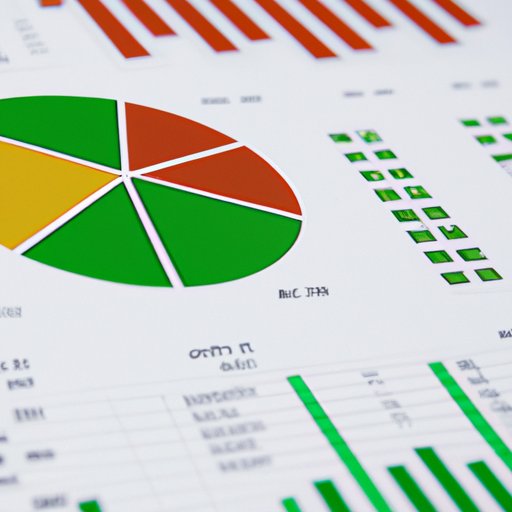
I. Introduction
Excel is a powerful tool for analyzing and interpreting data. It’s a popular choice among businesses, researchers, and students alike. If you’re new to data analysis, or if you’re looking to improve your skills, this article is for you. Below, we’ll guide you through everything you need to know about data analysis in Excel, from the basics to advanced topics.
Performing data analysis in Excel is essential for making informed business decisions, developing research findings and insights, and presenting information clearly. With Excel’s advanced features, you can easily calculate, organize, and visualize data.
II. A step-by-step Guide on How to Perform Data Analysis in Excel
Prior to diving into data analysis in Excel, it’s essential to understand what data analysis is and why it’s important. Data analysis is the process of examining and interpreting data in order to extract insights and information. It’s essential for decision-making and problem-solving.
Before starting with data analysis, it’s important to have a basic familiarity with Excel. You should be able to open and save files, enter data into cells, format cells and ranges, and work with basic calculations.
In order to perform data analysis in Excel, you’ll need to follow certain prerequisites, such as setting up the data in an organized manner, ensuring that the data is clean and free of missing values, and knowing which type of analysis to perform based on the data type.
Once all the necessary prerequisites are met, the step-by-step guide on how to perform data analysis in Excel starts with basic calculations such as finding the average or sum of a series by using functions such as SUM and AVERAGE.
Then you can move on to more advanced data analysis methods by using functions such as COUNTIF and FILTER to retrieve selected data from a table based on specific criteria, and VLOOKUP to search for data within tables.
You will also learn how to visualize data using charts and graphs, which is an effective way to communicate important insights and patterns in your data.
III. The Top 5 Data Analysis Functions in Excel
Data analysis functions are formulas used to perform specific calculations on data. They help to simplify complex data analysis tasks into easy and straightforward steps. Here are five of the most commonly used data analysis functions in Excel:
- SUMIF: Use this function to add up values in a range based on a specific condition.
- AVERAGEIF: Use this function to calculate the average of the values in a range that meet specific criteria.
- COUNTIF: Use this function to count the number of cells that meet specific conditions or criteria.
- FILTER: Use this function to display only the rows in a range that meet specific criteria.
- VLOOKUP: Use this function to search for a value in a table and retrieve corresponding values from a specified column.
You can perform a range of data analysis tasks by using these functions within Excel. Keep these functions in mind as we walk you through how to use them step-by-step to analyze your data.
IV. Using Pivot Tables to Analyze Data in Excel
Pivot tables are a powerful tool for analyzing and summarizing large data sets. They can be used to group and filter data, perform calculations, and generate visualizations.
The first step in creating a pivot table is to organize your data source in a table. Ensure that the data is clean, free of errors and missing values. You can then create a pivot table by selecting the data source and choosing PivotTable from the Insert tab on the ribbon.
You can explore the data by adding fields to columns and rows, applying filters, and aggregating data using different functions. Pivot tables can help you uncover trends, patterns, and insights that may not be immediately visible from your data set alone.
V. Excel Charts: The Ultimate Tool for Data Analysis
Charts and graphs are a powerful way to visualize data in Excel. Charts can help to highlight trends and patterns in data and communicate complex information in a clear and concise manner.
When creating a chart in Excel, it’s important to consider the type of data you’re working with and the message you want to communicate. For example, a pie chart may be appropriate for showing proportions, while a line chart may be better suited for showing trends over time.
There are several types of charts in Excel to choose from, such as bar charts, line charts, pie charts, and scatter charts. You can customize the chart’s appearance, including its size, colors, labels, and titles, for easy viewing.
VI. Unlocking Insights with Excel Data Analysis Add-ins
Excel offers several data analysis add-ins that can help you unlock further insights from your data. These add-ins are designed to expand Excel’s built-in functionality and provide additional tools and options for data analysis.
One example of an add-in is the Analysis ToolPak, which provides a wide range of statistical functions, such as regression analysis and hypothesis testing. Another example is Power Query, which enables you to import, merge, and transform data from various sources.
Other useful add-ins include Power Pivot, that extends Power Query’s capabilities with extra data structures and advanced data models; Power View, which helps to create interactive charts and reports; and Solver, which can model and solve complex scenarios.
VII. Conclusion
Performing data analysis in Excel can be both informative and rewarding. By following these step-by-step guides and using Excel’s diverse set of tools and functions, you’ll be better equipped to work with large sets of data, analyze trends, and create clear visualizations that help communicate important insights.
Remember to take things step by step, starting with the basics of data analysis, and building up your skills as you become more confident. Focus on trying out different approaches and methods, and applying what you’ve learned to real-world examples. With time and practice, you’ll become a proficient data analyst in no time.





